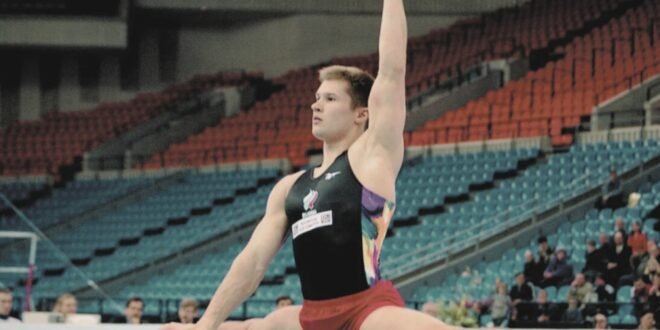Introduction
Gymnastics has long been a topic of debate among sports enthusiasts and purists. Is Gymnastics A Sport Yes Or No Is it truly a sport? This article will delve into the intricacies of gymnastics to determine whether it qualifies as a sport or not. We’ll explore the various elements that makeup gymnastics, its history, competitive aspects, and the physical demands it places on athletes.
Defining Sport Is Gymnastics A Sport Yes Or No
Before we can answer the question of whether gymnastics is a sport, we must first establish what defines a sport. Is it merely physical activity, or does it involve more nuanced criteria?
Physicality and Athleticism
Is Gymnastics A Sport Yes Or No
Gymnastics is renowned for its incredible physical demands. Athletes perform a wide range of acrobatic and strength-based movements, showcasing exceptional athleticism. We’ll explore the physical aspects that support the argument for gymnastics as a sport.
A Historical Perspective
The Origins of Gymnastics
To understand the sport of gymnastics, it’s essential to delve into its history. We’ll trace its origins and evolution from ancient Greece to the modern Olympic Games.
Competitive Gymnastics
Competitions are a hallmark of sports. Gymnastics boasts a rich tradition of competitive events, including the Olympics and World Championships. We’ll examine the competitive nature of gymnastics and how it aligns with traditional sports.
Artistry vs. Athleticism
The Graceful Component
Gymnastics is not only about physical prowess but also about grace and artistry. Athletes perform routines that blend athleticism with artistic expression. We’ll explore the artistic side of gymnastics and its impact on the sport’s perception.
Scoring and Judging
The intricate scoring and judging system in gymnastics sets it apart from many other sports. We’ll discuss how gymnastics judges Is Gymnastics A Sport Yes Or No evaluate performances and why this aspect may contribute to the debate about its classification as a sport.
Strength and Flexibility
Gymnasts must possess exceptional strength and flexibility. We’ll delve into the physical demands that gymnastics places on athletes and how these demands compare to those of traditional sports.
Risk and Injury
The risk of injury is inherent in gymnastics due to the complexity of its movements. We’ll examine the physical toll that gymnastics can take on athletes and how it compares to other sports.
Evolution of the Sport
Gymnastics is a dynamic sport that continues to evolve. New techniques, routines, and innovations are constantly being introduced. This adaptability is a characteristic often associated with traditional sports, demonstrating that gymnastics is not stagnant but rather continues to push boundaries.
Inclusivity and Accessibility
One of the hallmarks of a sport is its ability Is Gymnastics A Sport Yes Or No to be inclusive and accessible to a wide range of participants. Gymnastics programs for children and adults have become increasingly popular, promoting physical fitness and skill development. This inclusivity aligns with the values of many traditional sports.
Competitive Excellence
Gymnastics continues to showcase competitive excellence on the world stage. Athletes from various countries compete fiercely for medals and titles. The intensity and dedication seen in gymnastics competitions mirror the fervor found in other sports.
Governing Bodies and Regulations
Like traditional sports, gymnastics has governing bodies such as the International Gymnastics Federation (FIG) that establish rules and regulations for fair play. These organizations ensure that the sport maintains its integrity and competitiveness, similar to the oversight seen in other sports.
Unique Fusion
One of the aspects that make gymnastics fascinating is its unique fusion of art and sport. While traditional sports primarily focus on athleticism, gymnastics embraces both the beauty of movement and the physical prowess of athletes. This combination sets it apart but doesn’t necessarily exclude it from the realm of sports.

The Ongoing Debate
Cultural Influences
The perception of gymnastics as a sport or not is often influenced by cultural factors. Is Gymnastics A Sport Yes Or No In some cultures, gymnastics is considered a sport without question, while in others, its artistic elements may lead to differing opinions. This cultural variability demonstrates the complexity of the debate.
Sportification of Gymnastics
Over the years, gymnastics has evolved to become more sport-like. It has adopted elements such as strict training regimes, standardized rules, and a competitive structure akin to traditional sports. This sportification process aligns gymnastics more closely with conventional sports.
The Future Outlook
Continued Growth
Gymnastics shows no signs of waning in popularity. Participation rates continue to rise, and the sport remains a staple in schools and fitness programs. This sustained growth suggests that gymnastics is seen as a valuable athletic pursuit.
Evolving Definitions
As our understanding of sports evolves, so too may our perception of gymnastics. The boundaries between sports and other physical activities are becoming more fluid, making room for gymnastics to be recognized as a sport in its own right.
The Role of Perception
Public Perception Is Gymnastics A Sport Yes Or No
Public perception plays a significant role in determining whether gymnastics is seen as a sport. For many, the awe-inspiring performances of gymnasts during events like the Olympics solidify its status as a sport. The widespread viewership and fan following further reinforce this perception.
Media and Pop Culture
The portrayal of gymnastics in media and pop culture has also influenced its perception. Movies, documentaries, and television series often depict the rigorous training, competition, and triumphs of gymnasts, reinforcing the notion that it is indeed a sport.
The Athleticism Argument
Exceptional Physical Demands
Gymnastics requires a level of athleticism that is on par with many traditional sports. Athletes train rigorously to develop strength, flexibility, balance, and coordination, all of which are essential components of athleticism.
Competition and Achievement
Competitive gymnastics showcases high-level achievement. Athletes strive to outperform each other, aiming for perfect scores and gold medals. This competitive aspect aligns with the essence of sportsmanship found in other sports.
The Artistry Perspective
Artistic Expression Is Gymnastics A Sport Yes Or No
Gymnastics offers a unique platform for artistic expression. Routines are not just about executing movements but also about telling a story and captivating the audience. This artistic component sets gymnastics apart from purely athletic endeavors.
The Intersection of Art and Sport
Some argue that gymnastics represents the perfect intersection of art and sport, combining the grace and creativity of dance with the raw athleticism of traditional sports. This fusion challenges conventional definitions of sports.
The Future of Gymnastics
Evolving Definitions
As the world of sports continues to evolve, so too may our understanding of what constitutes a sport. The lines between sports, physical activities, and art forms are blurred, creating room for gymnastics to be appreciated in a broader context.
Inclusivity and Diversity
Gymnastics is becoming more inclusive, welcoming participants of all backgrounds and abilities. This inclusivity mirrors the values upheld by many sports organizations, emphasizing equal opportunities for all.
The Intersection of Science and Sport
Biomechanics and Physiology
The study of gymnastics from a scientific perspective sheds light on its athletic nature. Biomechanics researchers analyze the forces, movements, and physiological demands placed on gymnasts. Their findings often align gymnastics with traditional sports in terms of the physical stresses involved.
Injury Prevention and Rehabilitation
The field of sports medicine extensively covers gymnastics, focusing on injury prevention and rehabilitation. The fact that gymnasts require specialized medical care, akin to athletes in other sports, underscores its classification as a sport.
The Role of Governance
International Regulations
Gymnastics, like other sports, adhere to international regulations and standards set by governing bodies such as the FIG. These organizations ensure fair play, safety, and standardization, key characteristics of recognized sports.
Sport Funding
Gymnastics programs receive funding from national sports agencies, further emphasizing its recognition as a sport. These financial investments support athlete development, training facilities, and competitive participation, much like funding for traditional sports.
The Cultural Perspective
Tradition and Heritage
In many cultures, gymnastics has a long tradition and deep heritage. It is often intertwined with national identity and pride. This cultural significance reinforces its status as a sport in the eyes of many.
Spectator Engagement
Gymnastics competitions draw large audiences, both in-person and through televised broadcasts. The excitement and emotional investment of spectators mirror the fervor seen in traditional sports events.
The Fluid Nature of Sports
Expanding Definitions
The world of sports is evolving, broadening the definition of what qualifies as a sport. Emerging sports, such as esports and extreme sports, challenge traditional norms, suggesting that sports can take on various forms.
Embracing Diversity
The inclusivity of sports is expanding to embrace a wide range of activities and disciplines. This evolving landscape allows gymnastics to coexist alongside traditional sports, each celebrated for its unique qualities.
The Physical Challenges
Exceptional Strength and Conditioning
Gymnasts are renowned for their remarkable strength and conditioning. They undergo rigorous training regimens to develop the physical attributes required for their sport. This level of dedication to physical fitness is a hallmark of recognized sports.
Injury Risks
The physical demands of gymnastics come with inherent injury risks. Athletes often face the potential for injuries, including sprains, fractures, and strains. This risk is common in many sports, emphasizing the athletic nature of gymnastics.

The Competitive Landscape
Elite Competitions
Gymnastics boasts a calendar of elite competitions that rival those of traditional sports. Events such as the World Gymnastics Championships and national championships draw top athletes from around the world, showcasing the sport’s competitive depth.
National Representation
Gymnasts represent their countries on the international stage, much like athletes in other sports. The pride and honor associated with competing for one’s nation align with the patriotic aspects of recognized sports.
The Role of Training
Specialized Coaching
Gymnastics requires specialized coaching and training programs, similar to other sports. Coaches develop athletes’ skills, provide guidance, and prepare them for high-level competition.
Dedication and Commitment
Gymnasts demonstrate unwavering dedication and commitment to their sport. They train for countless hours, adhering to strict routines and regimens. This level of commitment mirrors the dedication seen in traditional athletes.
The Debate’s Evolution
Shifting Perceptions
Over time, perceptions of gymnastics have evolved. While it was once primarily seen as an art form, its classification as a sport has gained prominence. This shift in perception is indicative of its growing recognition within the sports community.
Table of Contents
Cultural Influence
The cultural significance of gymnastics varies across regions. In some countries, it is celebrated as a sport, while in others, its artistic elements may still take precedence. This cultural diversity highlights the complexity of the debate.
The Evolution of Judging
Objective Scoring
Gymnastics has embraced more objective scoring systems in recent years, moving away from subjective judging. The introduction of detailed scoring criteria has made it more akin to traditional sports, where scores are based on quantifiable performance metrics.
Technological Advancements
The use of technology in gymnastics judging has further blurred the lines between art and sport. High-speed cameras and motion analysis tools are employed to assess movements and provide precise scores, much like the technology used in other sports.
The Athletic Career
Lifelong Dedication
Gymnastics often requires lifelong dedication, starting at a young age. Athletes commit themselves to the sport, much like professional athletes in traditional sports who focus on their careers from an early age.
Collegiate Gymnastics
In the United States, collegiate gymnastics is a prominent sport. Athletes compete for their universities, receiving scholarships and support similar to collegiate athletes in recognized sports such as football and basketball.
The Spectator Experience
Thrilling Performances
Gymnastics competitions deliver thrilling performances that captivate audiences. The combination of athleticism and artistry creates a unique spectator experience, reminiscent of the excitement found in traditional sports events.
Global Fanbase
Gymnastics boasts a global fanbase that closely follows competitions and cheers for their favorite athletes. The passion and engagement of gymnastics fans mirror the fervor seen in fans of traditional sports teams.
The Olympic Movement
Olympic Recognition
Gymnastics is an integral part of the Olympic Movement, with gymnastics events dating back to the ancient Olympics. Its inclusion in the modern Olympic Games further solidifies its status as a sport.
Olympic Values
Gymnastics embodies the core values of the Olympics, including excellence, friendship, and respect. These values align with the principles upheld by recognized sports in the Olympic Games.
The Global Impact
International Competitions
Gymnastics is not limited to a specific region or culture. It has a strong presence on the international stage, with athletes from diverse backgrounds competing at the highest levels. This global reach is a characteristic shared with recognized sports.
Cultural Exchange
Gymnastics competitions foster cultural exchange as athletes from different countries come together to showcase their skills. This cultural exchange is a fundamental aspect of the Olympic spirit and aligns with the ideals of traditional sports.
The Pursuit of Excellence
Training Intensity
The intense training regimen of gymnasts mirrors that of athletes in traditional sports. They push their bodies to the limit, striving for perfection in their routines, and dedicating countless hours to achieve excellence.
Mental Toughness
Gymnastics demands mental toughness, similar to the mental fortitude required in traditional sports. Athletes must overcome fear, pressure, and nerves to perform at their best, reflecting the psychological aspects of competition.
The Path to Success
Olympic Dreams
Many gymnasts aspire to represent their countries at the Olympic Games, a dream shared by athletes in recognized sports. The pursuit of Olympic glory is a driving force in gymnastics, emphasizing its competitive nature.
Scholarships and Support
Gymnasts often receive scholarships and support to pursue their athletic careers, especially in countries where the sport is prominent. This financial assistance is akin to the support provided to athletes in traditional sports.
The Educational Component
Coaching and Mentorship
Coaching and mentorship are integral to gymnastics, much like in traditional sports. Coaches guide athletes in skill development, strategy, and competition preparation, contributing to their overall growth.
Educational Institutions
Gymnastics programs are commonly integrated into educational institutions, emphasizing the importance of academics alongside athletic training. This approach aligns with the values of holistic development seen in recognized sports.
Conclusion
In conclusion, gymnastics exhibits many characteristics of a sport. It involves physicality, competition, and a rich history of athletic achievement. However, its artistic elements and scoring system set it apart from conventional sports.
Whether gymnastics is considered a sport may ultimately depend on one’s perspective. Some may argue that it is a unique blend of athleticism and artistry, while others may view it as a distinct sport in its own right.
FAQ
Is gymnastics in the Olympics?
Yes, gymnastics has been a part of the Olympic Games since the early 20th century.
How do gymnastics competitions work?
Gymnastics competitions involve athletes performing routines on various apparatus, which are then scored by judges.
Are there different types of gymnastics?
Yes, there are various disciplines within gymnastics, including artistic gymnastics, rhythmic gymnastics, and trampoline gymnastics.
Can anyone participate in gymnastics?
Gymnastics is open to individuals of all ages and skill levels, from recreational to elite athletes.
What are some famous gymnasts?
Notable gymnasts include Simone Biles, Nadia Comăneci, and Olga Korbut.
 Cric Enjoy Sports News, Cricket Update, Live Streaming
Cric Enjoy Sports News, Cricket Update, Live Streaming







